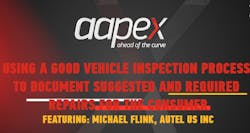Autel hosts vehicle inspection training session
Autel held a training session during the Virtual AAPEX Experience titled “Using a good vehicle inspection process to document suggested and required repairs for the consumer” where technicians learned the importance of taking vehicle inspections a step further in today’s world. The training was presented by Michael Flink of Autel.
Flink first shared the main reasons for initial inspections. Ultimately, visual inspections provide a record of the vehicle's current condition and what services are required, recommended, and/or suggested. Vehicle inspections give both the technician and customer a plan for the repair to be done, and what is or is not approved.
While there are many sources for technicians to find inspection sheets or templates to use, Flink advised techs to utilize one that feels the most comfortable to them and that best suits their shop.
Vehicle inspections help prevent failures on the road and are important for techs to complete as a service to customers. Vehicles nowadays may only visit a shop once or twice a year because maintenance times are longer.
“We need to let them know we’re not trying to get more out of them with these inspections,” said Flink. “We’re trying to ensure that their vehicle stays on the road, performing for them like they expect, getting the right fuel mileage, and other items.”
With the complexity of today’s vehicles, Flink noted that it’s important to inspect beyond the common visual items such as brake fluid, engine oil, drive belts, air filter, wiper blades, shocks, etc.
There's a lot happening behind the scenes at shops that consumer may not see, and codes that don’t give a warning to the driver, noted Flink. Only a technician using professional tools knows how to interpret the codes properly.
To do so, Flink suggested technicians perform a pre- and post-scan using a diagnostic tool into their inspection routine. These scans will supply the total condition of the vehicle, including any hidden items.
He noted many diagnostic or scan tools today have a pre/post scan feature. Some are even set up to enter or scan VINs and license plates.
When completing a pre-scan, he said it is best to use a repair order or work order number to identify and save the report. Some diagnostic tools allow users to save the order directly on the tool, making the invoice process easier.
Also, if possible, he recommends adding photos to document any damage or issues that the customer needs to be aware of, or for technicians to make note of pre-existing concerns.
In addition to completing a visual inspection and a pre-scan, Flink said checking the battery’s state of health, TPMS status, and tire condition and tread wear should also be part of the initial inspection process.
Once all reports are printed and accounted for from the diagnostic tools and a post-scan is complete, all information can be handed over to the customer and the repair plan can begin.
In all, these extra elements may take longer to complete, but Flink assures it will pay off in the long run.
“It will pay off in repeat customers and keep them from trading the car in and back in your shop,” concluded Flink.
About the Author
Kayla Oschmann
Assistant Editor | Vehicle Repair Group
Kayla Oschmann is assistant editor for the Vehicle Repair Group.
With an education in journalism and public relations, Oschmann contributes to Fleet Maintenance, PTEN, and Professional Distributor magazines, as well as VehicleServicePros.com.

